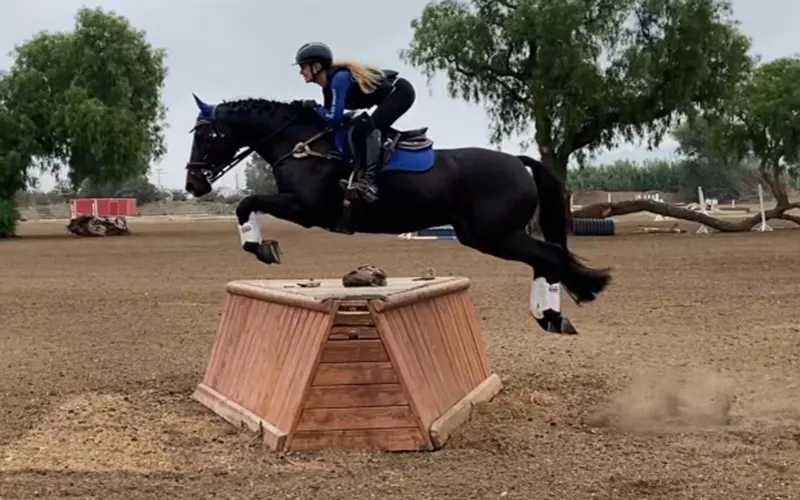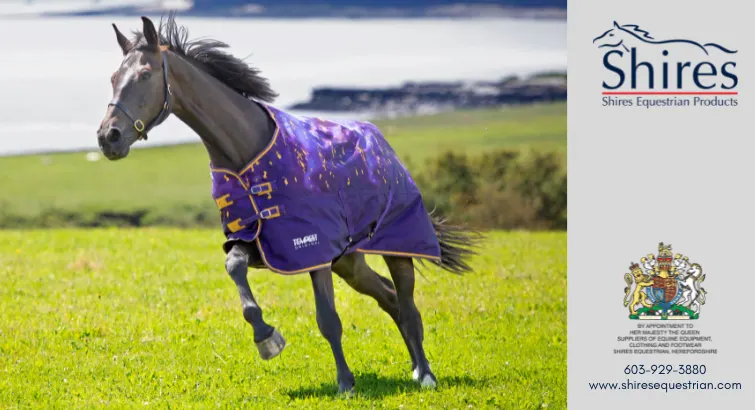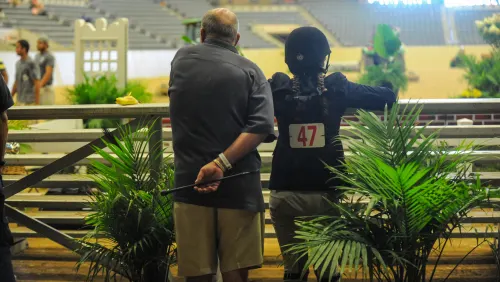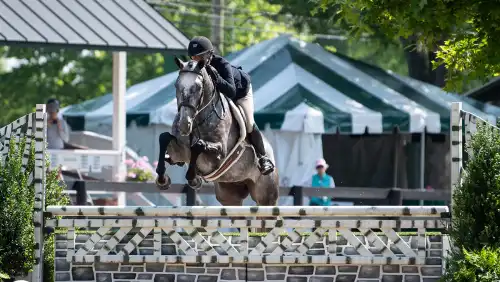Zoey Luna has always loved Thoroughbreds. As a teen, working under the guidance of Nancy Turrill at Foxfield Riding School in Westlake Village, California, Luna learned how to work with green and difficult horses, and she produced her first OTTB. When she turned pro at age 18, Luna started transitioning former racehorses into new careers as hunters, equitation mounts and jumpers. Now 26, Luna enjoys competing in the jumper ring on her string of Thoroughbreds.
If you visit her ZL Equestrian in Moorpark, California, a small, plain dark bay gelding named Troy likely won’t stand out. But with his own Instagram hashtag, #troythekillpenrescue and a string of successes in the 1.10-meter ring, Troy has come a long way from when he was known by a different hashtag: #7573 in a Texas feedlot.
In 2018, one of Luna’s clients was looking to adopt a rescue equine to be a companion for her older Quarter Horse. Her client searched social media, coming across a possible candidate at the Bowie livestock auction in Texas, and she shared the post with Luna. At first, Luna was skeptical that the animals in the sale were at risk of being shipped to slaughter—but she soon learned she was mistaken.
“It’s a little bit different now, but at the time there were a ton of horses that they would ask for maybe $100 more than meat price,” she said. “They would give them a week, and otherwise they’d go [to slaughter].”
Luna scrolled through the listings on the page, pausing when she saw two, 2-year-old Thoroughbreds. She considered purchasing one, but something held her back from committing, and when she logged back on several days later, the animals had been sold. It was a Wednesday night, and she knew that the animals still listed on the page would be shipped to slaughter on Friday morning. Curious to see what types of animals were still left in the pen, she continued scrolling.

Troy, shortly after he arrived to Zoey Luna’s barn in California and started to put on weight. Photo Courtesy Of Zoey Luna
“That’s when I saw Troy,” she remembered. “They had him listed as a 15.2 hand, 10-year-old, unstarted Thoroughbred. No microchip number. Unbroke—like, completely feral. They wanted $800, and that included his wormer and antibiotics.”
Luna scrutinized the few photographs the auction offered. Troy was small, slightly swaybacked and extremely thin. His bare feet were worn down to nubs; his mane and tail were matted solid, and on the limited video footage, he didn’t look sound.
“How many people are going to take a chance on an older, little Thoroughbred that was unhandled?” she said. “I kind of felt bad for him.”
Luna decided to purchase the gelding. She figured she had the skills to rehabilitate him and find him a home as a trail horse or a companion. Shipping him from Texas to Lancaster, California, (about one and a half hours north of Luna’s farm) cost more than his purchase price. When Luna made the trek to retrieve him, she found that the shipper had dropped Troy in a round pen. They needed to rope him to catch him and load him onto her trailer.
“That’s where the fun began,” Luna said with a laugh. “Being a Thoroughbred, he was tattooed, meaning at some point as a yearling, he at least got a name. Normally at 18 months, they start training. But he was never microchipped, so he never went to the track. Somewhere in between there, he never got started. I found this out the hard way.”
When Troy arrived at Luna’s farm in September 2018, he was severely foot sore. The first time Luna’s farrier worked on him, Troy needed to be sedated in order to be shod. Troy’s teeth also showed signs of neglect, with a full wave mouth that required three separate dental floats to fully resolve. (They also determined Troy was only 9, not 10.) But most concerningly, Troy’s mouth was filled with raw sores, and the veterinarian feared Troy had equine vesicular stomatitis—a highly contagious, reportable disease.
“Troy stayed in quarantine much longer than we had planned,” Luna said. “We cultured him and ran some labs. Fortunately, it wasn’t [vesicular stomatitis], but I just thought, ‘This is adding up very quickly from my $800 horse.’ ”
The veterinarian determined Troy’s mouth ulcers were likely the result of eating cheap cattle feed at the livestock auction; they slowly resolved while Luna gave him some time to rest and recover. About a month after his arrival, Luna began gradually introducing foundation skills to Troy’s daily routine, including tying, leading and exposure to items like saddle pads. Initially, Luna approached Troy’s training as she would with any off-track horse. But she soon figured out that Troy would require a different approach.
“I don’t know what kind of handling he did have,” she said. “I’m not going to say he’s a perfect boy now—he’s a little quirky, and that’s why he’ll never leave me—but I think he’s seen a harsh hand. He’s bombproof to any atmospherical thing going on—at a show, the world could be falling apart, and he will stand there, not spooking. But if you approach him with a really strong presence, or walk in very quickly at him, he shies away like you’re going to hit him.
“I don’t know what happened—I have no way of knowing. He has some calcifications on his ribs and the bridge of his nose—he has white hairs and scarring there. At first, I couldn’t get the halter on him. I had to step in sideways, not looking at him, and slide it over his head. Initially, he wouldn’t eat, and I treated him for ulcers. There were a lot of ups and downs.”
Later that fall, Luna began basic under saddle work. While a video taken of his second canter under saddle went viral with almost half a million views thanks to what Luna describes as “full-on, PBR bronc mode,” in general he made steady progress after the first few rides.
“The funny thing about Troy is that once we got the ball rolling, and he figured out that [being ridden] wasn’t that bad, things came along pretty quickly,” Luna says.
In December 2018, three months after his arrival, Luna took several horses to the Thoroughbred Classic Horse Show held at the Los Angeles Equestrian Center (California). Troy was still far too green to compete, but she brought him along for the mileage.
“I figured I would just take him to see how he reacted, but he did not understand,” she said. “You could see he definitely thought he was back—he was really stressed. He didn’t eat, and walking him was like a freight train just charging around. They have a showmanship class where you can walk and trot in hand, and I’d thought I would do that. But there was absolutely no way.”
When they returned home, Luna changed her approach with Troy. She started to simply spend lots of low-key time with him—just hanging out in the round pen or standing quietly at the mounting block—working to build a trusting relationship . Eventually, their bond became so strong that Troy could work bridleless and at liberty, following Luna around the ranch with what she calls a “latched-on join up.”
“It was the littlest things that were time consuming but trust building, and now, he’d do anything,” she said. “If I asked him to jump fire, he would. I think he knows, maybe, and I know it sounds corny—he knows he was on the brink of shipping and in a bad place.”
ADVERTISEMENT
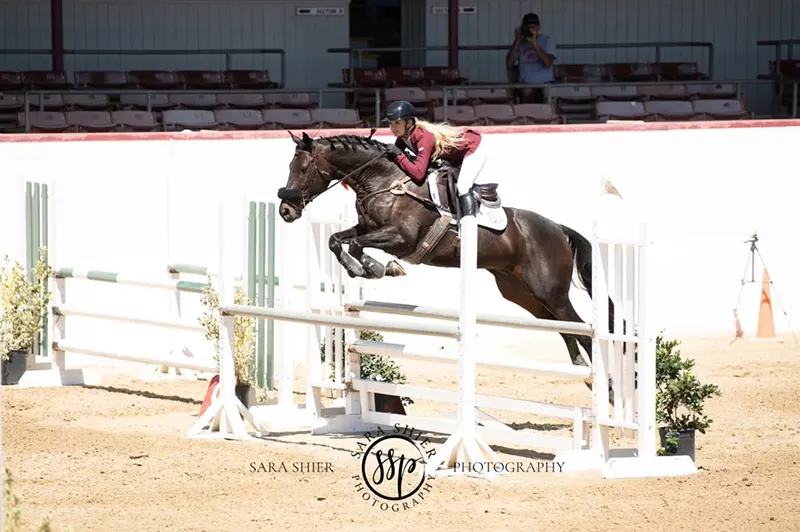
Troy has become a reliable 1.0- and 1.10-meter horse, and Luna hopes to show him in a few 1.15-meter classes this year. Sara Shier Photography Photo
Luna’s change in focus paid off, and Troy began to make steady progress both in and out of the arena. Though he didn’t take naturally to jumping at first, Luna applied the same slow and steady approach until Troy figured out what to do with his feet. About a year after she got him, she felt he was ready to return to the show ring, and this time it was a success.
“He never says no—ever, it’s just not in his dictionary,” she said. “He’ll take anything from anywhere, whether I think it’s a good idea or not! He’s super cool, and I can’t say enough good things about him.”
Since then, Luna has shown Troy under the name Ever So Clever in 1.0-meter and 1.10-meter classes with good success, and she hopes to enter him in a few 1.15-meter classes this season.
“He never says no—ever, it’s just not in his dictionary,” Luna says of her 15.2-hand kill pen rescue. Photo Courtesy Of Zoey Luna
“He’s done the 1.10 [-meter] classes a lot—it is an absolute cakewalk for him,” Luna said. “He’s the horse in the barn I would trust to do anything. At our last barn, he’d gallop up the hills. Some shows have a cross-country field, and he’ll go jump the training and preliminary fences. He’s small yet mighty, the little Energizer bunny.
“I’m a jumper by heart for sure, but we do all of it,” Luna continued. “Thoroughbreds are such versatile horses, and in a sense, you are missing out in how much they can do if you don’t take the opportunity to do all of it. So, Troy does it all. He goes on the beach, on the trail, cross-country schooling, dressage, liberty, jumpers.”

Luna doesn’t event, but she takes opportunities to take Troy cross-country schooling when possible. Photo Courtesy Of Zoey Luna
Luna admits Troy still has his quirks around human body language, can’t handle alfalfa (“it makes the motor run for years and years”), and gets fat on air. But he’s found a permanent place in Luna’s barn and in her heart.
“The thing I always say about him is he is my rock,” Luna said. “Troy is always there like, ‘Yup, I can do it.’ ”
Do you know a horse or pony who has been rescued from a dangerous situation to become a healthy, trusted competition partner today? If you think you have a good candidate for “From Rescue To Ribbons,” let us know by emailing mwright@coth.com.



